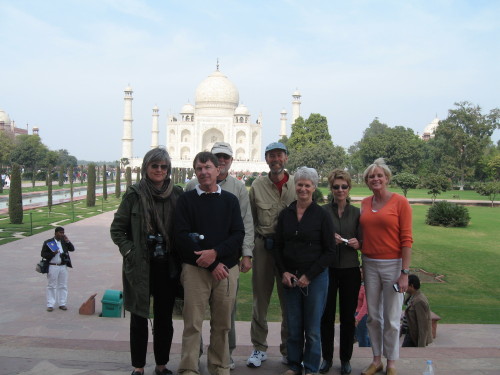India and Nepal, 2008
In January 2008 a group of us from Mercy Corps traveled to India and Nepal on a fact-finding mission to look at some projects sponsored by the Phoenix Fund.
India
CHAI
In 2002, Starbucks, through their subsidiary Tazo Tea and in collaboration with Mercy Corps, started the Collaboration for Hope and Advancement in India, known by its all-too-clever acronym CHAI. The project is located in the Darjeeling region of northern India, an area of rugged mountains, hard on the Nepalese border. While the actual tourist town of Darjeeling is relatively wealthy, the surrounding areas are very poor, dominated by ethnic Nepalese and Tibetans who make, perhaps, a dollar or two a day picking tea in the local tea estates.
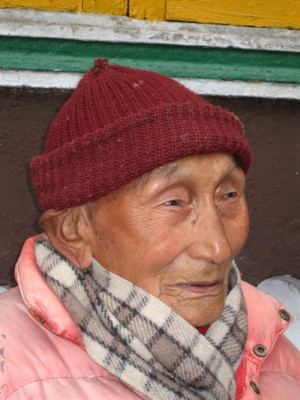
While the long-running civil war in neighboring Nepal is well-known, less well-known is the ethnic tensions in the Darjeeling region between the governing Indians and minority groups in Darjeeling, which occasionally break out into outright violence (indeed, we were caught up in one such dispute). Over the last 20 years, there has been a low-grade guerilla war between the government (dominated by the Indians) and a separatist movement, who were looking to succeed from West Bengal, the Indian state in which Darjeeling lies, and form their own Gorkhaland state. The hope of the separatists was that if they had their own state, they could at least expect to keep a large part of the tax money flowing out of the region.
While the principle objective of the CHAI project was to improve the livelihood of the 11,000+ people living in the region, an indirect goal was to reduce tensions by providing employment opportunities and by increasing the economic ties between the various groups.
The Factory
In late 2006, the Phoenix Fund received and funded a proposal from the CHAI project to start a factory to produce handmade paper. The idea was that the paper would be used in environmentally-friendly premium packaging for the higher-quality teas in the region. Our objective with the trip was to visit the factory, now called the Manokamana Handmade Paper Factory.
What we found is a situation all-to-familiar in our experience with these kinds of light manufacturing projects. They tend to put lots of energy into producing product, sometimes with spectacular results, but are less certain about what to do when it comes to sales and marketing. Fortunately, the general manager of CHAI, the very smart and very charming Sanjay Gurung, is well aware of the problem. We offered what advice we could give and moved on.
During the visit, I took a lot of pictures illustrating how the factory produces its paper.
Strike
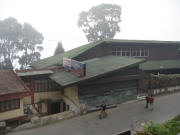
I mentioned that this region has seen its share of strife. Unfortunately, we ran into some of it as we tried to leave. The day we visited the factory one of the local political leaders shot someone else, but because he was a member of the dominant political party, the local police were slow to do anything. Incensed, the opposition called a general strike — nothing was to move or get done. We heard about the strike and decided to leave very early the next morning in an attempt to beat it out of there before the streets were closed off. Unfortunately, 5 am wasn't early enough. We left in thick fog in the dark, but before we even got out of Kurseong, the town where we were staying, a crowd of young men surrounded us and starting banging on our vehicles. One of them reached through the driver's window and grabbed the keys. Fortunately the drivers were cool and didn't overreact. After a protracted negotiation with the strike's leader we came to a compromise. We couldn't leave, but we could at least chill at the local hotel where we had spent the previous night.
As a precaution, the local "commandos" detailed an armed detachment who sat outside the hotel, AK-47s at the ready for who knows what. Certainly didn't make me feel any safer. I couldn't take any pictures of this because they wouldn't let me.
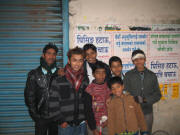
After about 8 hours of this, Joni Kabana and I got bored and decided to walk the streets. What had started out as a tense situation had devolved into a holiday with families in the streets, barbeques, cricket, and music!
Finally, at just about dark, word came that the issue had been resolved, the gunman turned himself in, and we were allowed to go. By this time, we were hopelessly behind schedule, with about 1 hour to do the 8 hour drive back down out of the hills, across the Nepalese border, then back up into the mountains, this time to our next stop in eastern Nepal.
Nepal
Crossing the border
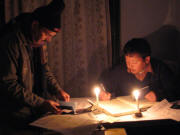
Because of the delays caused by the strike we didn't get to the Nepalese border until about 10pm, long after the immigration officers had gone to sleep! Fortunately, our local guide "BP" was not to be deterred and roused them out of bed. Another problem was that there is no electricity at night, so the officers lit a bunch of candles and went about issuing our visas by flickering candlelight!
After crossing the border, we pressed on to our campsite, which BP and his crew had set up earlier in the day and crawled into our tents and sleeping bags. At about 3am I woke up to Jean yelling my name, desperation in her voice. The plastic table and chairs in the kitchen tent were on fire! Apparently, the last to go to bed had left some candles burning stuck to the table. Eventually, they burned down far enough to ignite everything. I put my boots on and went about stomping and throwing dirt on the dripping plastic for about 20 minutes until all was well.
When we went to bed, it wasn't really clear exactly where we were. However, once we woke up, it was obvious: we were camped right in the middle of the village of Phikal, surrounded by the huts of the curious and sleepy-eyed villagers. Our latrines were dug on the edge of the schoolyard!
Cardamom plantations
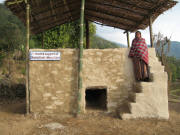
The next day, ourselves bleary-eyed from lack of sleep, we continued on to the cardamom plantations, which we had come to visit.
As part of the same round of proposals that funded the CHAI projects, we also funded a set of production, marketing, and distribution initiatives for some cardamom plantations in eastern Nepal. This region is a stronghold of the Maoist revolution in Nepal and, as a result, had been torn apart by conflict, as well as government neglect and corruption.
Cardamom has long been a cash crop for the farmers, but due to primitive drying methods, as well as their naive marketing strategies, they were receiving very low prices for their otherwise very high quality crop. The objective of the Phoenix Fund project was to upgrade the drying kilns as well as to assist two exporters to improve their ability to compete in the global cardamom market. We did this by by working with about 100 farmers and funding a demonstration project in the hope that the ideas and techniques would catch on.
Four villages were provided with fuel-saving dryers that, instead of drying the cardamom over open flames resulting in black, smoky-tasting seeds, used indirect heat. The result is beautiful, pink colored seeds, with a strong and delicious flavor all its own.
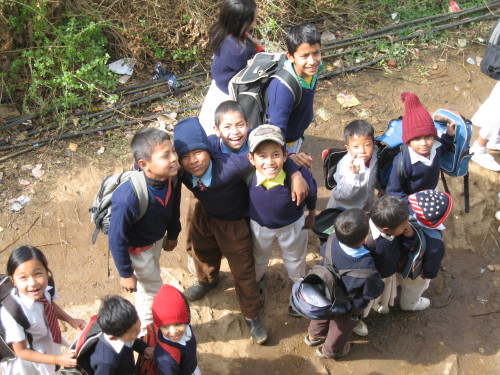
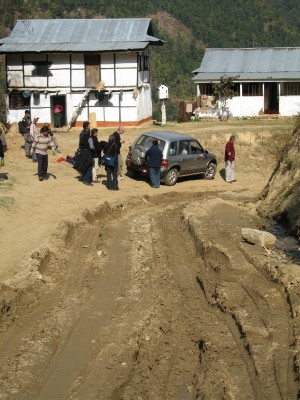
Getting to the plantations was a great adventure! Starting from our campsite, already deep in the mountains, we journeyed for about four hours up a long, windy road to Ilam, and then on to Phidim, the local commercial center. We then continued down a rutted and muddy road to our destination. Along the way, we had to abandon one of our four-wheeled drive vehicles, which wasn't up to the deep ruts, and pile into the two remaining vehicles. I shared the tailgate of a Discovery Land Rover for the four hours it took us to get to our destination with the delightful Tej, a local Nepalese, who works for Mercy Corps. Incidentally, Tej told me that most of the time when he visits the villages, he doesn't have a vehicle and so he walks the 40-50 km! It takes him a full day.
The roads were rough, but once we got there, the reception was worth it! Taking advantage of the occasion, the locals decided to declare this the "First Annual Cardamom Festival" and a few hundred people showed up! They had music, drums, dancing, and generally had a good time.
We hadn't eaten all day, so when evening fell our guides made us some soup and we ate it while sitting around in plastic chairs (wherever you go, there are always plastic chairs) in the middle of the crowd. Always the center of their intense interest, we felt very self-conscious eating while everyone stared at us. I asked Tej if all these people were really hungry and he assured me that, while there are lean times in these villages, this one wasn't one of them. They were just curious and wanted to be there "in case anything interesting happens." Still, as we passed around a can of Pringles (another ubiquitous western icon) and then casually offered it to one of the locals, he politely took it and then bolted into the crowd, disappearing.
That night we again camped out, this time next to a local monastery with about 50 curious locals surrounding the tents, watching our every move. When we woke up at dawn, they were still there.
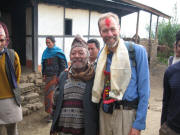
We were at our apogee. The next morning it was time to start our long trek back home, beginning with a walk down from the aerie where we had camped. A memory: all of our luggage had to be hauled up to the campsite, and then back down. One of the women had brought along an enormous suitcase, the sort you might take on a cruise liner, and weighing perhaps 30 pounds. While we gingerly worked our way down the muddy trail from the campsite, her suitcase was given to an 8 year old kid to bring down. He cheerfully hoisted it on his back and took off down the trail at a fast jog, half his body weight behind him, and without so much as a smudge, delivered it safely to the vehicles waiting below.
